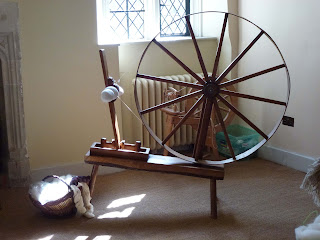On Saturday I took part in an event which was linked to the BBC series The Great British Story - A People's History. The series is about the everyday lives of ordinary people in Britain through history.
To accompany the series there are events being held around the country to help people discover more about their past. The event I took part in was at Hall Place, a Tudor House in Bexley, Kent. I went with my friends Viv and Della - from Wye Community Farm, and Della's daughter Cat. We represented the Kent Guild of Spinners, Dyers and Weavers.
It was an unusual brief. Normally we rock up with our wheels and things we have made and take the day as it comes. The usual 'script' is about the process of spinning wool. This time the brief was different. We were there to give people a peek into the past. Now I consider myself to be a 21st century spinner, I don't particularly spin to recreate history, I spin in the here and now. Could I manage to talk all day about the lives of women in the past? I really wasn't sure if I knew enough about the history of spinning.
Then there was the matter of deciding what to take for display. As it was an event with a history focus I asked my fellow Guild members to loan items which would fit in with the historical theme - nothing mill spun, nothing chemically dyed, nothing modern in design. That limited our choice of display materials but on the day we could honestly say that everything was handspun and either undyed or dyed with historic natural dyes.
The display looked good and showed people what could be achieved with ancient techniques. Guild members even lent a replica great wheel and a genuine antique flax wheel - which fell apart at every opportunity.
 |
| Yarns naturally dyed by Guild members |
 |
| The Great Wheel |
We met members of the Guild of One-Name Studies, they research surnames and had seen many occupations related to wool in the census returns but were not sure what those occupations would have involved. It was exciting swopping knowledge to gain a better picture of the lives of textile workers in the past.
The TV programme, presented by Michael Wood, airs on BBC2 on Fridays at 9:00pm.
Thanks to Cat Newman for the photographs.



Fabulous, it's great to be part of days like that.
ReplyDeleteInteresting question on books on the history, would be interested in reading anything myself, sorry no ideas here though.
I'll have to do some research.
DeleteI tried to comment from my new smart phone and it would not let me. Boohoo.
ReplyDeleteThis is cool. Learning more about the history of spinning when you didn't even know you wanted to.
I'll see if I can't find a book on Swedish spinning for you. --haha lol - just kidding. You know Spinning is now a term used for stationary bike riding at the gym?
I have a great book from the library right now on the history of Swedish Quilts. Very much of the scrappy quilts - used clothing to make wonderful designs.
When you think all that fabric was made by hand it was far too valuable to throw away, no wonder people made quilts from the scraps.
Delete